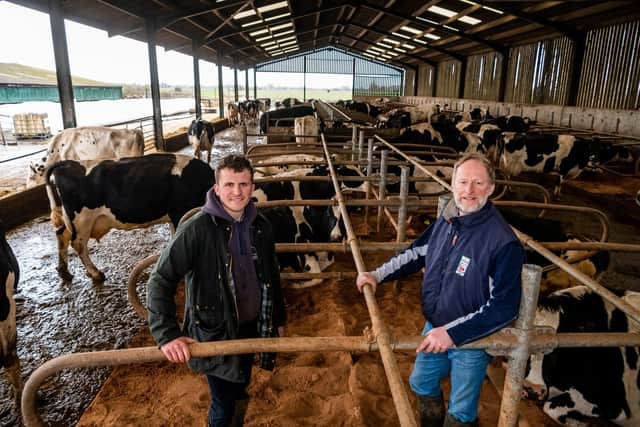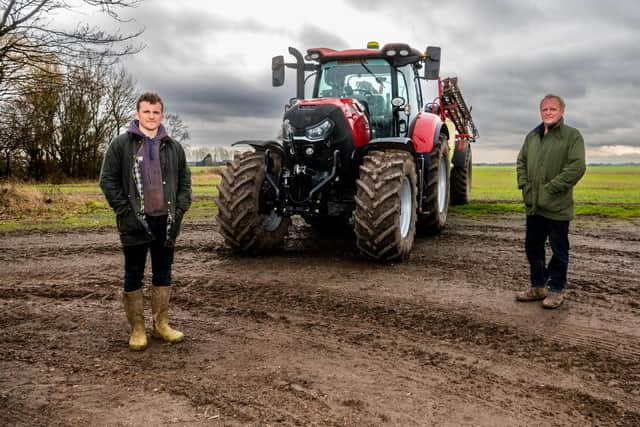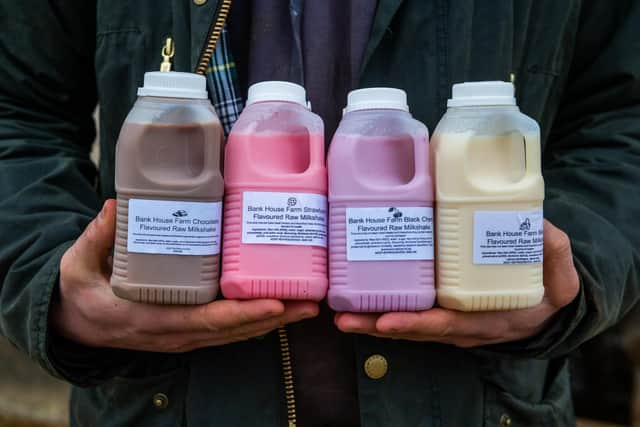Farm of the Week: Dairy family whose 'raw' milk is loved by customers as a health product
Half a century later John’s sons James and Matthew and James’ son Sam now farm across
1500 acres with half owned and the other half contract farmed and rented from John’s brother David.
Advertisement
Hide AdAdvertisement
Hide AdSadly, John passed away and the family farm today is a partnership between James and Matthew with James responsible for the arable side and Matthew the dairy side which sees them milking 220 cows with milk going almost 100 per cent to Payne’s Dairies, except for the latest development at the farm that Matthew said was started during the Covid years.


“What happened was that during the first lockdown in 2020 everybody was running scared of going to a shop. We’ve a busy road going past the farm and we had quite a few people come in and say can we buy milk from you?
“I spoke to Sam about it and we decided we’d get a fridge, a container, put up a sign and start a trial and people liked it. We had decided to sell raw milk, because that’s what we drink.
Sam then looked more into the benefits of raw milk and found that they had something unique for their area. Everyone could buy regular milk from their shops when the scare lessened, but by then the Brookes had found a niche market.
Advertisement
Hide AdAdvertisement
Hide AdSam said what started as an easy roadside purchase has now become a passion because of the following which has grown from local work people through to families and those seeking out raw milk.


“We’re on a busy road (A18) and trucks and vans will stop regularly, not necessarily because it is raw milk but simply because it is milk and easy to purchase. We don’t use vending machines. Buyers just come, take the bottles from the fridges and pop their money in an honesty box.
“On a weekend we do well with parents and grandparents bringing children up for the milkshakes. We produce four regular varieties and specials throughout the year. Once again, they don’t necessarily come because it is raw milk but because of where we are.
“But we really have become passionate about raw milk and its health benefits. It helps those with lactose intolerance, skin condition, stomach condition and diabetes and we get people from miles away because they want it. We’ve even had someone who said it helped with their hay fever. I don’t know how it has done that, but what we do know is that people love it.
Advertisement
Hide AdAdvertisement
Hide Ad“We bottle it ourselves and make our own labels. We sell the milk in 2 litre plastic bottles and milkshakes in half litres. It’s a drop in the ocean compared to the amount that goes to Payne’s but it provides another little income stream and one where we feel we are doing some good.


Matthew said the dairy herd at Bank House is predominantly Holstein but with Ayrshire cows and that he has been breeding in a bit of Friesian.
“We are just trying to give a bit of stature and type. We used sexed semen from a Friesian type bull called Inch Brilliant last year on our younger cows because the genetics are now better in our younger stock. We are using British Blue on our older cows and sweep up with two Aberdeen Angus bulls.
“Our average yield per lactation is 8500 litres which is a little below what we used to be but our milk from forage has gone up because the type we now have are better forage converters.
Advertisement
Hide AdAdvertisement
Hide Ad“Our grazing conditions are generally good and while the cows are generally out to grass 7-8 months of the year our low yielders only came in on December 11, 2022 and we usually aim to get all of the cows out by the middle of March if the weather is favourable.
“We have a ready market with other local farmers for our beef calves that leave here anywhere from a week old to 6 weeks. We don’t put many through a livestock market unless we have to and we have a man from Derbyshire who picks up our culled cows.
Matthew is happy with the way the milk price is performing at present but remembers what it was like for many years.
“We were fortunate that the arable farming side could subsidise the dairy for a long while. We now need prices to be like this for another 5-10 years to make up for what we lost during those bad times.
Advertisement
Hide AdAdvertisement
Hide Ad“We started selling to Payne’s three years ago after having been with a number of others over the past years since vesting day in 1995. We like Charlie (Payne) because he’s hands on, you can talk direct with him and you don’t have to jump through hoops to sell your milk to him.
James said that min-till has become the norm on the farm’s arable acreage which sees them growing 750 acres of winter wheat this year with first wheat varieties Extase and Siskin and second wheats Lantern and Shabras; 70 acres of winter barley; 150 acres to be sown of spring barley variety Planet; 300 acres of oilseed rape; 70 acres of spring beans and 30 acres of maize with 120 acres of rotational grass.
“We go from sandy silty land to heavy clay with everything below sea level and yield on average somewhere between 3.5 to 4 tonnes per acre most years.
“Lantern is a hybrid of Relay that was a really good second wheat. We use a bit of barley and wheat, plus the maize for the cows but we largely trade the major crops. We also let 30 acres for potatoes.
Advertisement
Hide AdAdvertisement
Hide Ad“We only plough for the maize. We haven’t ploughed extensively for quite a while. We are still using a combination drill, because sometimes we need to knock soil over again but we are doing our best with looking after the soil.
“Like everyone else we have blackgrass, but we watch for it keenly and spot treat it. We also suffer a bit with flea beetle.
“Our rotation is either two consecutive wheats and then rape or beans or grass on heavy land and on lighter soils only one wheat and a break, because we have quite a lot of maize and grass in there.
“We do most of the work ourselves. The only things we use contractors for is a bit of muckspreading and silage work.
James said the farm is in Entry Level stewardship.
Advertisement
Hide AdAdvertisement
Hide Ad“We have some flower rich margins and wild bird cover and grass margins around the big ditches. We are currently looking at what is involved with the new schemes.
Sam spent a year in New Zealand last year working for a silage contractor and took in what was happening on their farms.
“They are using a lot of drones to record their farming operations which are then uploaded on social media. I’ve now bought one and have begun filming our farm promoting our raw milk and milkshakes.